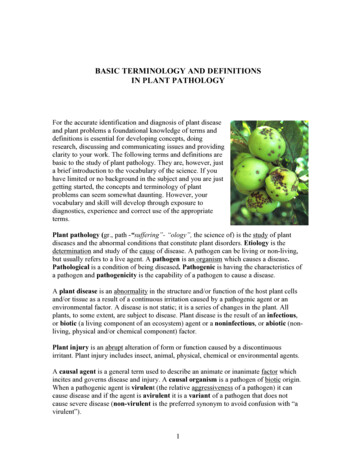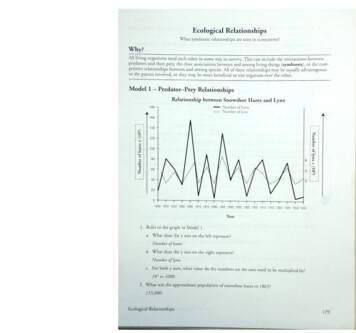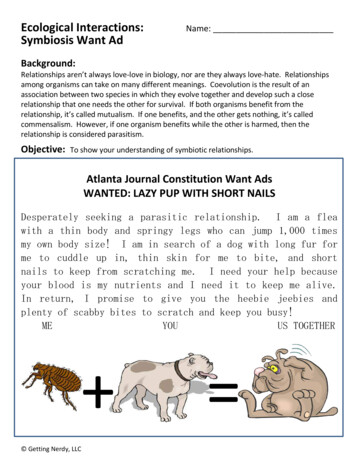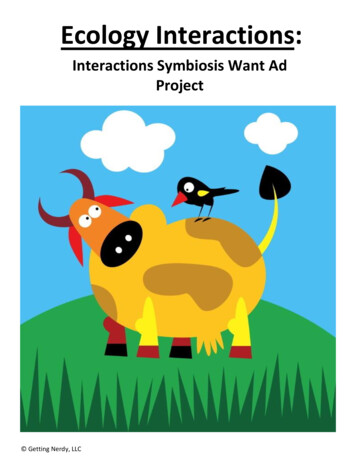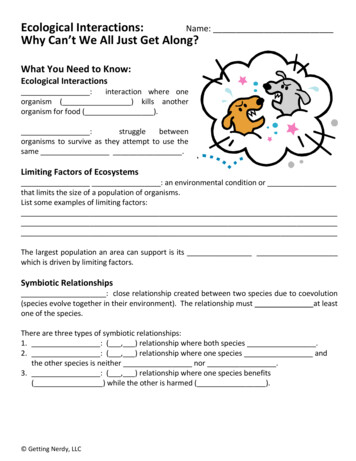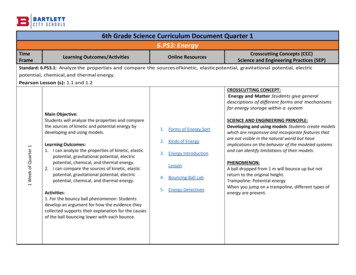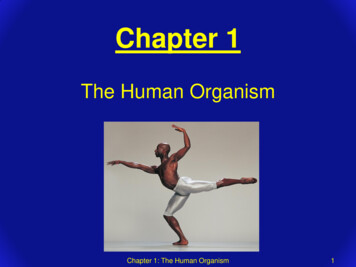
Transcription
Chapter 1The Human OrganismChapter 1: The Human Organism1
Chapter 1 Outline1.1 Anatomy and Physiology1.2 Structural and functional organization of the human bodyA.11 Organ Systems1.3 Characteristics of Life1.4 Biomedical Research1.5 HomeostasisA.B.Negative feedbackPositive feedback1.6 Terminology and the Body planA.B.C.D.E.F.Body PositionDirectional termsBody parts and regionsPlanesBody CavitiesSerous MembranesChapter 1: The Human Organism2
1.1 Anatomy and PhysiologyAnatomy Scientific discipline thatinvestigates bodystructure & examines therelationship betweenstructure and functionPhysiology Scientific investigation ofthe processes or functionsof living things. Goal:– Understand & predict body’sresponses to stimuli– Understand how the bodymaintains conditions with anarrow range of values in aconstantly changingenvironment.Study of the human body encompasses bothbecause they are highly interwoven.Chapter 1: The Human Organism3
Various types of study: Anatomy: Physiology:– Developmental Anatomy Embryology– Cytology Histology– Gross Anatomy Regional Systemic– Surface Anatomy– Anatomical Anomalies––––Cell PhysiologySystemic �� Exercise physiology Usually physiologicalstudy is systemicbecause functions occurin multiple places in thebody.– PathologyChapter 1: The Human Organism4
Anatomical Imaging1. Radiograph2. Ultrasound3. Computedtomography4. Dynamic subtractionangiography5. Magnetic resonanceimaging6. Positron emissiontomography Table 1.1 Page 3Chapter 1: The Human Organism5
1.2 Struc & Fxnl Organization- Human Body1. Chemical Level:Involves interactions2. Cellular Level:of atoms comingtogether to form more Basic structural &complex molecules.fxnal units of plants &animals6. Organism:Any living thingconsidered as a wholewith all 11 organ systemsworking together.3. Tissue Level:A group of similar cells &the materials surroundingthem, this combinationdetermines its fxn.5. Organ System:Group of organs thattogether perform acommon fxn or set offxns and are thereforeseen as a unit.4. Organ Level:Struc composed of 2 ormore tissue types thatperform 1 or more fxns.UrinarybladderChapter 1: The Human Organism6
The 11 Organ Systems1.2.3.4.5.6.Integumentary SystemSkeletal SystemMuscular SystemLymphatic SystemRespiratory SystemDigestive System7. Nervous System8. Endocrine System9. Cardiovascular System10.Urinary System11.Reproductive SystemChapter 1: The Human Organism7
Organ Systems of the BodyIntegumentary SystemAnatomy: Skin, hair, nails, &sweat glandsPhysiology: Provides protectionPrevents water lossHelps producevitamin DSkeletal SystemAnatomy: Bones, ligaments, joints, &associated cartilagesPhysiology: Provides protection &supportAllows body movementsProduces blood cellsStores minerals and fatsChapter 1: The Human OrganismMuscular SystemAnatomy: Skeletal muscle & tendonsPhysiology: Produces body movementsMaintains postureProduces body heat8
Organ Systems of the BodyLymphatic SystemRespiratory SystemDigestive SystemAnatomy:Anatomy:Anatomy: Lymph nodes, lymphaticvessels, & other lymphaticorgansPhysiology: Maintains fluid balanceRemoves foreign substancesfrom blood & lymphCombats diseaseAbsorbs fat from digestivetractLungs & RespiratorypassagesPhysiology: Exchange carbondioxide for oxygenRegulates blood pHPhysiology: Chapter 1: The Human OrganismMouth, esophagus, stomach,intestines, & accessoryorgansMechanical & chemicaldigestionAbsorbs nutrientsElimination of wastes9
Organ Systems of the BodyNervous SystemAnatomy: Brain, spinal cord, nerves, &sensory receptorsPhysiology: Major regulatory systemDetects sensationsControls Movements Physiologicalprocesses Intellectual functionsEndocrine SystemAnatomy: Glands (ex/ adrenal gland)Physiology: Major regulatory systemMANY fxnsInfluences Growth Metabolism ReproductionCardiovascular SystemAnatomy: Physiology: Chapter 1: The Human OrganismHeart, blood vessels, & bloodTransports Nutrients Gases Waste products HormonesPlays a role in the immuneresponsePlays a role in bodytemperature regulation10
Organ Systems of the BodyReproductive SystemUrinary SystemMALEAnatomy: Kidneys, Bladder, andAssociated ductsPhysiology: Removes waste from bloodRegulates Blood pH Ion balance Water balanceAnatomy: Testes, Penis, Ducts, &Accessory structuresPhysiology: Produces and transferssperm to femaleProduces hormones thatinfluence sexualfunctions & behaviorsChapter 1: The Human OrganismFEMALEAnatomy: Ovaries, Vagina, Uterus,Mammary glands, &associated structuresPhysiology: Produces oocytesSite of: Fertilization Fetal developmentProduces milk for newbornProduces hormones thatinfluence sexual functions &behaviors11
1.3 Characteristics of Life1.Organization 2.Condition in which theparts of an organism havespecific relationships toeach other and those partsinteract to perform specificfxns5.All chemical reactions thattake place in an organism6.Organism’s ability to detectchanges (D’s) in it’sinternal or externalenvironments and adjust tothose D’sIncrease in the size or # ofcells resulting in overallenlargement of all or partof an organismDevelopment Responsiveness Growth Metabolism 3.4.Changes an organismundergoes through timebeginning with fertilizationand ending with deathReproduction Production of new cells ornew organismsChapter 1: The Human Organism12
1.4 Biomedical Research Although we use alternative methods forunderstanding the functions of the body(for example animal or cell studies), andthese have lead to ground breakingadvances in technology and health care,some things require human subjects ofstudy. Although these methods are helpfulthey are not exacting, such thatmisinformation can occur.Chapter 1: The Human Organism13
1.5 Homeostasis The existence &maintenance of arelatively constantenvironment in thehuman body that issuitable to supportlife.– Set-point perfection– Normal range we canlive withChapter 1: The Human Organism14
1.5 Homeostasis:2 systems are used to maintain this balance1. Negative Feedback Primary (1o) fxn maintain homeostasisand decrease anydeviations from the norm.2. Positive Feedback 1o fxn increasedeviations from norm. Few in the body MOST are harmful– Leads body away fromhomeostasis and in worstcase into death– Abnormal Blood Loss– Normal LaborChapter 1: The Human Organism15
Parts of Feedback SystemsControl CenterEvaluates incominginformation & makes achoice. When somethingis wrong this is whatdecides which action mustbe takenOnce thatchoice is madeReceptorEffector Monitors/watches somethingand reports itsfindingsHelps carry out theaction that will:1. Increase deviationfrom homeostasis2. Stop deviationfrom homeostasisChapter 1: The Human Organism16
Negative FBDecrease BPReceptorBaroreceptor in Blood VesselsNerveImpulsesDecrease theHeart RateOutput ofNerve ImpulsesControl CenterBrain- Interprets inputChapter 1: The Human Organism17
Positive FBStretchingofthe CervixReceptors“Stretch Sensitive”Output*Birth*No more stretchingNo more feedbackEffector: UterusContractionCervix StretchesControl CenterBrain- Interprets inputOutputOxytocinChapter 1: The Human Organism18
Terminology and Body Plan1. Anatomical Position– Erect facing forward arms on the side with palms facingforward2. Supine– Lying face up3. Prone– Lying face down Directional Terms Body parts and regions Planes Body Cavities Serous Membranes19Chapter 1: The Human Organism
Anterior (Ventral) Posterior (Dorsal) Superior (cephalic) Inferior (Caudal) Superficial Deep Proximal DistalChapter 1: The Human OrganismDirectional Terms Medial Lateral20
Anterior (Ventral) Posterior (Dorsal)Chapter 1: The Human OrganismDirectional Terms Medial Lateral21
Anterior (Ventral) Posterior (Dorsal) Superior (cephalic) Inferior (Caudal)Chapter 1: The Human OrganismDirectional Terms Medial Lateral22
Anterior (Ventral) Posterior (Dorsal) Superior (cephalic) Inferior (Caudal) Proximal DistalChapter 1: The Human OrganismDirectional Terms Medial Lateral23
Anterior (Ventral) Posterior (Dorsal) Superior (cephalic) Inferior (Caudal) Superficial Deep Proximal DistalChapter 1: The Human OrganismDirectional Terms Medial Lateral24
25Chapter 1: The Human OrganismBody Parts Upper Limb Lower Limb Central Region Head Neck Trunk
Abdominal Regions4 Quadrants9 tRightlumbarregionRightiliacregionChapter 1: The Human liacregion26
Sagittal Right and left halves Meidan- perfect halves Coronal/ Frontal Front and back halves Transverse/Horizontal Top and bottom halvesSections of an organTransversePlaneCoronalplane Longitudinal Along it’s long axis Cross Section Right angle to it’s long axis Oblique Any angle along the long axisthat isn’t a right angle27Chapter 1: The Human OrganismPlanesSagittalPlane
DorsalVentral Cranial Thoracic Spinal Mediastinum Pericardial Pleural Abdominopelvic Cavity Abdominal Pelvic28Chapter 1: The Human OrganismBody Cavities
Chapter 1: The Human OrganismSerous Membranes Serous Membranes Line the trunk’s cavitiesA. Parietal Lines the wallsB. Visceral Covers the Organ There is a fluid that issecreted between Aand B that helpslubricate and protectorgans from damage29caused by friction
1.2 Struc & Fxnl Organization- Human Body Chapter 1: The Human Organism 6 1. Chemical Level: Involves interactions of atoms coming together to form more complex molecules. fxnal A group of similar cells & the materials surrounding them, this combination determines its fxn. 3. Tissue Level: 2. Cellular Level: Basic structural & units of plants .


